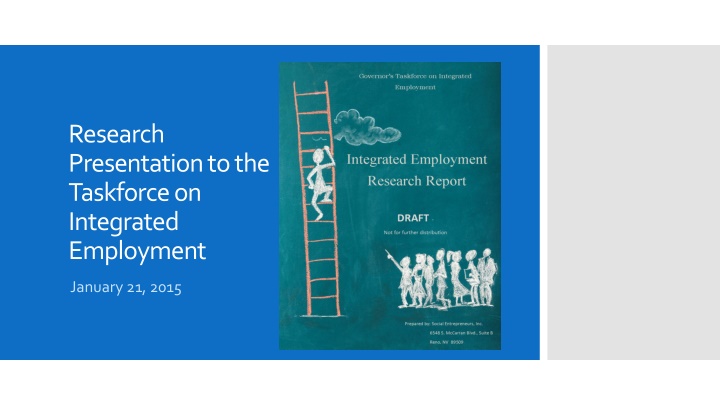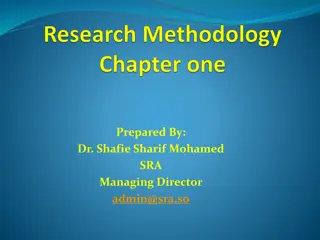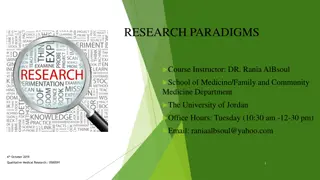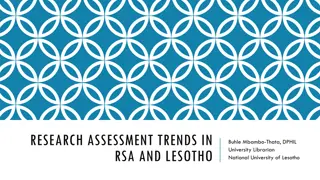
Empowering Individuals with IDD: Integrated Employment Research Presentation
The Taskforce on Integrated Employment aims to establish a sustainable system for individuals with intellectual and developmental disabilities (IDD) to attain competitive, integrated employment. The taskforce is responsible for evaluating current programs and resources, developing strategic plans, and exploring policies and funding to enhance workforce integration. The research report encompasses an overview of Nevada's employment landscape for individuals with IDD, best practices, needed legislation, funding opportunities, and collaborative partnerships. By reviewing national and state reports, the research underscores the importance of promoting Integrated Employment and offers insights from key resources like the Office of Disability Employment Policy.
Download Presentation

Please find below an Image/Link to download the presentation.
The content on the website is provided AS IS for your information and personal use only. It may not be sold, licensed, or shared on other websites without obtaining consent from the author. If you encounter any issues during the download, it is possible that the publisher has removed the file from their server.
You are allowed to download the files provided on this website for personal or commercial use, subject to the condition that they are used lawfully. All files are the property of their respective owners.
The content on the website is provided AS IS for your information and personal use only. It may not be sold, licensed, or shared on other websites without obtaining consent from the author.
E N D
Presentation Transcript
Research Presentation to the Taskforce on Integrated Employment January 21, 2015
Mission The Taskforce mission is to develop and implement a sustainable system for individuals with intellectual and developmental disabilities (IDD) to achieve competitive, integrated employment in the setting of their choice. Executive Order 2014-2016
The Taskforce is responsible for examining and evaluating current employment programs, resources, funding, available training, and employment opportunities for individuals with intellectual/developmental disabilities and is also responsible for developing a three, five, and ten- year strategic plan (2015-2025) that will result in creating a more integrated workforce and expanding competitive employment opportunities for individuals with intellectual/developmental disabilities. Charge to the Taskforce
1. Overview of the current situation in Nevada regarding integrated employment practices and programs for individuals with IDD 2. Models and best practices to support and promote education, employment opportunities and outcomes, and other habilitation services for individuals with IDD Contents of the Research Report 3. Policies and legislation needed to create a more diversified, inclusive, and integrated workforce 4. Funding opportunities, potential partners, and collaborations to consider
Research included review of over 50 national and state reports, briefs, papers and plans related to Integrated Employment. Some key resources Office of Disability Employment Policy. Integrated Employment Toolkit. The National Governors Association Center for Best Practices (NGA Center,2012). A Better Bottom Line: Employing people with disabilities. Blueprint for Governors. About the Research
National organizations have developed a series of reports, recommendations and briefs related to Integrated Employment or Integrated Competitive Employment (ICE). The State Employment Leadership Network Accomplishments Report summarizes progress in seventeen member states in 2009-2010 in areas such as waiver service definitions, Employment First policies and strategies, funding and rate methodology changes, and sharing data across state agencies. About the Research
Association of People Supporting Employment First (APSE) providing a starting point with the APSE Employment First Statement. The Institute for Community Inclusion, (Butterworth, J., Smith, F., Hall, A., Migliore, A., Winsor, J., & Domin, D.) has published annually, StateData: The national report on employment services and outcomes. State Activities to Implement Employment First as the Employment Strategy for Individuals with Intellectual and Developmental Disabilities (Jennings, Jr., E. T., & Zhiwei, Z.,2013). About the Research
A number of states have developed Integrated Employment Plans. Nevada Governor's Council on Developmental Disabilities (2014). Changing Nevada's Employment Landscape-Increasing Integrated Employment Outcomes for Nevadans with Intellectual/Developmental Disabilities. Position Statement on Integrated Employment. Harrington, S.-D., Sykes, S., & Wassmuth, C. (2012). Nevada Disability Employment Resource Guide 2011 - Diversifying Nevada's Workforce. About the Research
Nevadas proposed high performance model is a revision based on the model found in the National Report on Employment Services and Outcomes, 2013. It creates a framework to build on the aforementioned programs. Models already exist that Nevada can leverage
A Proposed Model
A Proposed Model
Key Themes from the Research
Government represents a significant opportunity to advance employment opportunities for people with disabilities. Government can Take a leader s role Act as a model employer for people with disabilities Show the business community the way to invest in integrated employment Strategies can include creating a fast-track hiring process, focusing on retention, and setting hiring goals Government as a model employer
The business community is critical to improving employment outcomes for people with disabilities Businesses are willing but need support from schools and government to address barriers that people with disabilities face To engage business, the Taskforce needs to understand the business perspective AND Show businesses how hiring people with disabilities will meet businesses needs (loyalty, productivity) Government should not rely solely on the business community but be a long-term support agent and resource Businesses as an employer and partner
Transition and career-readiness services should be provided from middle school on starting earlier leads to better outcomes Strategies include incorporating career-readiness content into educational curriculum, linking college and university services with career services, and providing specific knowledge and skills to be successful Hands-on work experience during high school, whether paid or not, increases the chances of finding employment with higher wages after they graduate Early and timely school assessment and planning for transitions
It is critical to address the traditional paradigm of prepping young individuals with disabilities for a life of benefits and change it to prepping young individuals with disabilities to a life of work State policies and strategies should promote The inclusion of individuals with disabilities to the workforce by making integrated employment a priority, and Implementing the same strategies used with the broader workforce A cultural shift
Coordinated schools and economic development authorities Close coordination between schools and economic development authorities is critical This allows schools to help students with disabilities develop the right skills they need to enter the workforce Employers then benefit from a broader pool of skilled applicants
Leverage limited resources Utilize multiple funding streams Capitalize on federal programs Connect with private-sector and philanthropic resources Maximize disability experts efforts This includes ensuring that Nevada is fully matching the federal funding for vocational rehabilitation. Sustainable funding
Set and measure progress toward employment goals Set and measure the return on investment of disability employment programs Use information on progress to improve programs Encourage others to participate in measuring results Orientation to results
Current Situation Part 1--Data
Supported employment outcomes for Nevadans with intellectual/developmental disabilities should include: Working in the community at competitive wages Making a financial impact on the economy Diversifying the workforce Improving quality of life Nevada Governor s Council on Developmental Disabilities, Position Paper
Nevada Governor s Council on Developmental Disabilities, Position Paper All adults in Nevada including Nevadans with intellectual/developmental disabilities should expect independence and competitive employment However, for those Nevadans with IDD who do not currently choose employment, meaningful day habilitation should be an option
Optimize the use of limited resources and make some financial concessions to make supportive employment services fiscally viable Rehabilitation Division funding could be used to leverage job and day training services to provide meaningful job readiness skills and prepare individuals for competitive employment Day habilitation s providers should improve and increase programming geared toward competitive employment and become a provider of supported employment job development services Nevada Governor s Council on Developmental Disabilities, Position Paper
Major accomplishments from these sessions still in progress, include: Medicaid Infrastructure Grant Funding Customized Employment Pilot Study Nevada Career Development Academy Nevada Employment First Ad Hoc Committee System Improvements were made to make employment the first option for Nevadans with an IDD and use new and existing funding sources to make programs a reality NGCDD Employment Policy Summit (2010)
More than half of the states in the nation are implementing comprehensive Employment First policies Minnesota established the state as a model employer of people with disabilities and made WorkForce Centers accessible and usable to everyone Maryland provides job seekers with disabilities the tools they need to be confident in their job search, such as resume and cover letter building and interviewing skills Iowa integrates work conducted by state agencies to train qualified workers with the skills businesses need, and is launching a team of statewide mobility managers to help job seekers with disabilities solve problems related to transportation State and National Research
According to the 2011-2013 American Community Survey 3-Year Estimates, 331,319 or 12.2 percent of Nevada s civilian non-institutionalized population were individuals with disabilities. Of this total: 25,568 were under 18 years old 178,959 were 18 to 64 years old 126,792 were 65 years old and over The number of people with disabilities varies by county Demographics
In 2013, 11 percent of Nevada students were receiving special education through an Individualized Education Plan or IEP This was slightly higher than previous years but still below the average nationally Education
Nationwide, students with disabilities are less likely to graduate from high school compared to people without disabilities In 2012, the nationwide average showed that 61 percent of students with disabilities graduated from high school, compared to 80 percent for the population as a whole In Nevada for the same year, youth with disabilities were considerably less likely to graduate than their peers; only 24 percent of youth with disabilities graduated from high school compared to 63 percent total (National Center for Education Statistics, 2014) Graduation from high school is essential for many jobs and secondary education Education
According to the 2010-2012 American Community Survey 3-Year Estimates, a total of 66,608 people with disabilities were employed in Nevada, and 16,274 were unemployed While this data shows unemployment rates as similar between people with disabilities and with no disabilities, a very large component (more than half) of all people with disabilities are not in the labor force (U.S. Census Bureau) Nevadans with disabilities are less likely to be employed full-time and earn less compared to those without disabilities Employment
2,175 individuals participated in day and employment services funded or monitored by the Nevada IDD agency 457 were in integrated employment services, including both individual job supports and group-supported employment. (May have been working or have been on a pathway to employment) (21% of total funded is higher than 18% nationally but doesn t include those not receiving any service) Nevada s total funding for day and employment services was $24,880,463 For integrated employment services funding was $3,707,733 Participation in day and integrated employment services, 2012
Themes and Strategies Part 1--Research
Make disability employment part of the state workforce development strategy (policy, program and funding) Be a model employer by increasing the number of people with disabilities working in state government (policy) Make state employment website accessible, known, easy to navigate Redirect resources to integrated employment services Ensure sufficient integrated transition, employment, vocational, and day services and supports Government as a model employer
Support Collaboration across agencies serving people with disabilities Support Entrepreneurs with Disabilities (include business development and incubators) Certify disability-owned businesses Government as a model employer
Engage businesses and assess their needs Help businesses find people with disabilities that match their needs Dedicate staff with business expertise who can make the business case Assign one point of contact from the state to work with employers over the long term Providing skills assessment and training Navigate the complexities of benefits related to workers with disabilities Businesses as an employer and partner
Work with multiple businesses within a sector Link to Economic Development efforts Include small businesses Businesses as an employer and partner
Incorporate career-readiness content into educational curriculum Link state colleges and universities disability services with career services Provide students with specific knowledge and skills to be successful Assess early and envision a life of work Identify dreams Early and timely school assessment and planning for transitions
Ensure policies prioritize employment Allocate resources toward integrated employment Engage all stakeholders in planning the transition Engage the public and educate them about ICE to reset expectations across the state Shift thinking from disability to ABILITY A cultural shift
Integrate youth with disabilities in existing state efforts to improve college and career readiness Co-locate vocational rehabilitation counselors and services in high schools Provide other career-readiness and career exploration services, such as career and job fairs, job shadowing, and career-focused mentoring Coordinated schools and economic development authorities
Ensure that Nevada is fully matching the federal funding for vocational rehabilitation Establish clear goals for rates and contracting structures Make changes to funding rates based on the real costs of providing high quality integrated employment Convene all agencies that pay for employment services Work on systemic change to the funding system Provide easy-to-understand resources for individuals, families, and employers to learn about the benefit options Sustainable funding
Set and measure progress toward employment goals Set and measure the return on investment of disability employment programs Use information on progress e to improve programs Encourage others to participate in measuring results Strengthen data collection systems Orientation to results
Recommendations for Strategic Planning
1. Involve all stakeholders in the improvement of interagency collaboration and communication. 2. Engage individuals with disabilities in developmental career NGCDD Employment Policy experiences at a younger age. 3. Develop and institute training and educational systems and public awareness programs for people with disabilities, providers, families, employers, and community partners that focus on employment of individuals with developmental disabilities.
4. Review, define, revise, implement and enforce a reimbursement structure for service providers that increases employment of NGCDD Employment Policy persons with disabilities. 5. Expand and enhance transportation options for persons with disabilities. 6. Define, expand and educate the use of assistive technology to increase employment options.
There are measurable increases in employment of citizens with disabilities within the general workforce, earning minimum wage or higher with benefits. Greater opportunities exist for citizens with disabilities to pursue self-employment and the development of microenterprises. Employment is the first and preferred option when exploring goals and a life path for citizens with disabilities. Characteristics of Successful Implementation of Employment First
Citizens with disabilities are employed within the general workforce, regardless of the severity of disability and assistance required. Young people with disabilities have work experiences that are typical of other teenagers and young adults. Employers universally value individuals with disabilities as an integral part of their workforce, and include people with disabilities within general recruitment and hiring efforts as standard practice. Characteristics of Successful Implementation of Employment First
Individuals with disabilities have increased incomes, financial assets, and economic wealth. Citizens with disabilities have greater opportunities to advance in their careers, by taking full advantage of their individual strengths and talents. Funding is sufficient so that quality services and supports are available as needed for long- term employment success. A decision not to consider employment in the community for an individual is re-evaluated on a regular basis; the reasons and rationale for this decision are fully documented and addressed in service provision. Characteristics of Successful Implementation of Employment First
Increase expectations about the employment potential of youth and adults with disabilities, including those with complex lives for whom competitive employment has been very limited. Develop a unified state and local public policy agenda and framework. Promote (re)investment of public resources to increase opportunities and access. Recommend- ations related to implementing principle goals of Employment First
Implement policies and practices that educate job seekers about possibilities and encourage employment as a real choice. Increase the employment participation rate of Nevadans with disabilities in the workforce. Promote economic prosperity of vastly unemployed and underemployed Nevadans with disabilities. Recommend- ations related to implementing principle goals of Employment First
Leadership Clear and unambiguous commitment to employment in individual community jobs, from top leadership through all levels in the system. Local and state-level administrators are champions for employment. Strategic goals and operating policies Employment is identified as the preferred outcome in state developmental disabilities policy, and is supported by program goals and operating practices that are clearly designed to achieve that objective. Recommend- ations on a framework for systems change (SELN)






















